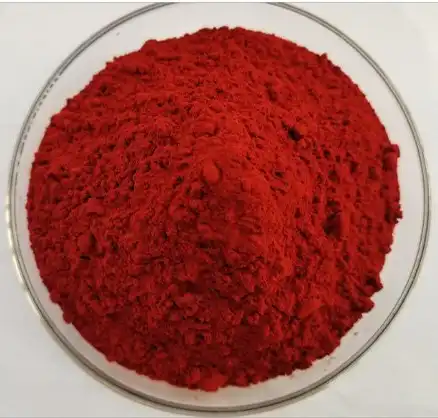How Stable Is Capsanthin Powder in Food Processing?
Capsanthin powder, a vibrant red pigment derived from paprika, has gained popularity as a natural food colorant. However, its stability during food processing can be a concern for manufacturers. This article delves into the factors affecting capsanthin powder's stability and explores methods to enhance its performance in various food applications.
Factors affecting capsanthin powder's oxidation stability in foods
Capsanthin, like many carotenoids, is susceptible to oxidation. This process can lead to color fading and degradation of the compound's beneficial properties. Several factors influence the oxidation stability of capsanthin powder in food systems:
Temperature
High temperatures accelerate oxidation reactions, making capsanthin more prone to degradation. This is particularly relevant during food processing and storage. Manufacturers must carefully consider the thermal stability of capsanthin when incorporating it into products that undergo heat treatment.
Light exposure
Capsanthin is photosensitive, meaning it can degrade when exposed to light. UV radiation and visible light can trigger oxidation reactions, leading to color loss. Proper packaging and storage conditions are crucial to maintain the stability of capsanthin-containing products.
Oxygen presence
Oxygen is a primary catalyst for oxidation reactions. The presence of oxygen in food systems can significantly impact the stability of capsanthin powder. Minimizing oxygen exposure through appropriate packaging and processing techniques can help preserve the pigment's integrity.
pH levels
The acidity or alkalinity of the food matrix affects capsanthin stability. Generally, capsanthin exhibits better stability in slightly acidic environments. However, extreme pH conditions can accelerate degradation.
Presence of pro-oxidants and antioxidants
Pro-oxidants, such as certain metal ions, can promote oxidation reactions and decrease capsanthin stability. Conversely, antioxidants can help protect capsanthin from oxidation, enhancing its stability in food systems.


Does capsanthin retain color under high-temperature processing?
The stability of capsanthin powder under high-temperature processing is a critical consideration for food manufacturers. While capsanthin does exhibit some heat sensitivity, its performance can vary depending on the specific processing conditions and food matrix.
Thermal stability in different food systems
Research has shown that the thermal stability of capsanthin can differ significantly based on the food system in which it is incorporated. For example:
- Oil-based systems: Capsanthin tends to exhibit better thermal stability in oil-based formulations compared to water-based systems. The hydrophobic nature of the lipid environment can provide some protection against heat-induced degradation.
- Emulsions: In emulsion systems, the stability of capsanthin can be influenced by factors such as droplet size, emulsifier type, and the presence of antioxidants. Proper emulsion design can help improve the thermal stability of capsanthin during processing.
- Solid matrices: When incorporated into solid food matrices, such as baked goods or extruded snacks, capsanthin may show enhanced stability due to reduced mobility and limited oxygen exposure.
Processing techniques and their impact on capsanthin stability
Different food processing techniques can have varying effects on the stability of capsanthin powder:
- Pasteurization: Mild heat treatments used in pasteurization generally have minimal impact on capsanthin stability, especially when processing times are short.
- Sterilization: High-temperature sterilization processes can lead to more significant color loss and degradation of capsanthin. However, the extent of degradation depends on factors such as time, temperature, and the protective effects of the food matrix.
- Baking: The stability of capsanthin during baking can vary depending on factors such as temperature, baking time, and product composition. In some cases, the formation of Maillard reaction products during baking may help protect capsanthin from degradation.
- Extrusion: The high-temperature, high-shear conditions of extrusion processing can pose challenges for capsanthin stability. However, proper formulation and process optimization can help mitigate color loss.
Strategies to improve thermal stability
To enhance the thermal stability of capsanthin powder during high-temperature processing, several strategies can be employed:
- Antioxidant addition: Incorporating natural or synthetic antioxidants into the formulation can help protect capsanthin from heat-induced oxidation.
- Microencapsulation: Encapsulating capsanthin within protective matrices can shield it from thermal degradation and improve its overall stability.
- Process optimization: Adjusting processing parameters such as time, temperature, and oxygen exposure can help minimize capsanthin degradation while still achieving the desired product characteristics.
- Synergistic combinations: Combining capsanthin with other stable pigments or colorants can help maintain the desired color even if some degradation occurs during processing.
Encapsulation methods to improve capsanthin's light and pH stability
Encapsulation technologies have emerged as powerful tools to enhance the stability of sensitive compounds like capsanthin. By creating a protective barrier around the pigment particles, encapsulation can significantly improve capsanthin's resistance to light exposure and pH fluctuations.
Spray drying
Spray drying is a widely used encapsulation technique that involves atomizing a liquid containing capsanthin and a carrier material into hot air. This process results in the rapid formation of dry powder particles with capsanthin entrapped within a protective matrix.
Advantages of spray drying for capsanthin encapsulation include:
- Improved light stability: The solid matrix formed during spray drying can provide a physical barrier against light penetration, reducing photodegradation of capsanthin.
- Enhanced pH stability: By selecting appropriate carrier materials, the encapsulated capsanthin can be protected from extreme pH conditions in food systems.
- Increased dispersibility: Spray-dried capsanthin powder often exhibits improved dispersibility in various food matrices, facilitating its incorporation into different products.
Emulsion-based encapsulation
Emulsion-based encapsulation techniques involve creating oil-in-water or water-in-oil emulsions to protect capsanthin. These methods can be particularly effective for improving the stability of capsanthin powder in liquid and semi-solid food systems.
Key benefits of emulsion-based encapsulation include:
- Controlled release: Emulsion systems can be designed to release capsanthin under specific conditions, such as pH changes or enzymatic activity in the digestive system.
- Improved bioavailability: Emulsification can enhance the bioavailability of capsanthin by increasing its solubility and facilitating absorption.
- Compatibility with liquid foods: Emulsion-based capsanthin formulations can be easily incorporated into beverages, sauces, and other liquid food products.
Nanoencapsulation
Nanoencapsulation involves creating capsanthin-containing particles on the nanoscale, typically ranging from 10 to 1000 nanometers in size. This advanced encapsulation technique offers several advantages for improving capsanthin stability:
- Enhanced light protection: Nanoencapsulation can provide superior light protection by reducing the surface area exposed to light and creating multiple layers of protection around capsanthin molecules.
- Improved pH stability: Nanoencapsulated capsanthin can be designed to withstand a broader range of pH conditions, making it suitable for use in diverse food applications.
- Increased dispersibility: Nanoencapsulated capsanthin particles often exhibit improved dispersibility and stability in various food matrices, reducing the risk of sedimentation or separation.
Cyclodextrin complexation
Cyclodextrins are cyclic oligosaccharides that can form inclusion complexes with capsanthin, effectively encapsulating the pigment within their internal cavity. This encapsulation method offers several benefits:
method offers several benefits:
- Enhanced light stability: The inclusion of capsanthin within cyclodextrin cavities provides protection against light-induced degradation.
- Improved solubility: Cyclodextrin complexation can enhance the water solubility of capsanthin, facilitating its use in aqueous food systems.
- Controlled release: The cyclodextrin-capsanthin complex can be designed to release the pigment under specific conditions, such as temperature changes or enzymatic activity.
By leveraging these encapsulation methods, food manufacturers can significantly improve the stability of capsanthin powder in various food processing applications. The choice of encapsulation technique depends on factors such as the specific food product, processing conditions, and desired stability profile.
Conclusion
Understanding the stability of capsanthin powder in food processing is crucial for maximizing its potential as a natural colorant. By considering factors such as temperature, light exposure, and pH, manufacturers can optimize their formulations and processing conditions to preserve the vibrant color and beneficial properties of capsanthin.
Encapsulation technologies offer promising solutions for enhancing capsanthin stability, enabling its use in a wider range of food applications. As research in this field continues to advance, we can expect to see even more innovative approaches to improving the performance of capsanthin powder in food systems.
Are you looking for high-quality, stable capsanthin powder for your food products? Angelbio specializes in the research, development, and production of natural ingredients for the food and nutrition industry. Our team of experts is dedicated to providing innovative solutions that meet the highest quality standards. Contact us today at angel@angelbiology.com to learn more about our capsanthin powder offerings and how we can help you create vibrant, stable food products that delight consumers.
References
1. Giuffrida, D., et al. (2020). Stability of carotenoids during food processing and storage: A review. Food Research International, 137, 109359.
2. Martínez-Tomé, M., et al. (2019). Encapsulation of carotenoids: A review. Trends in Food Science & Technology, 88, 259-269.
3. Saini, R. K., & Keum, Y. S. (2018). Carotenoid extraction methods: A review of recent developments. Food Chemistry, 240, 90-103.
4. Zhao, X., et al. (2021). Recent advances in the stability and delivery of astaxanthin and other carotenoids: A review. Trends in Food Science & Technology, 113, 193-204.


